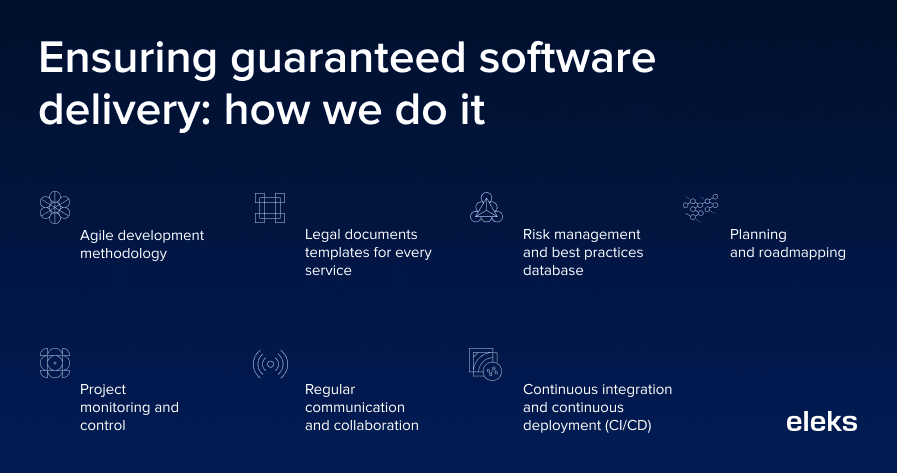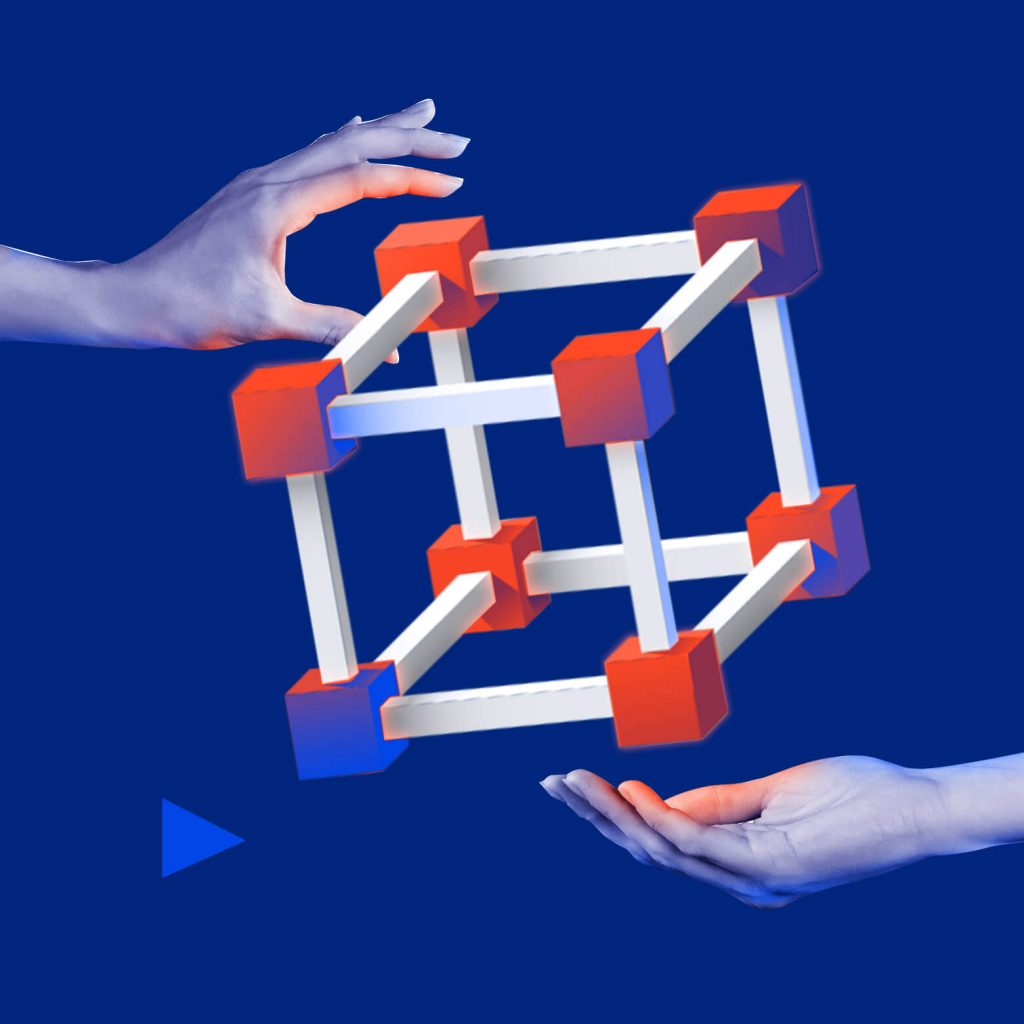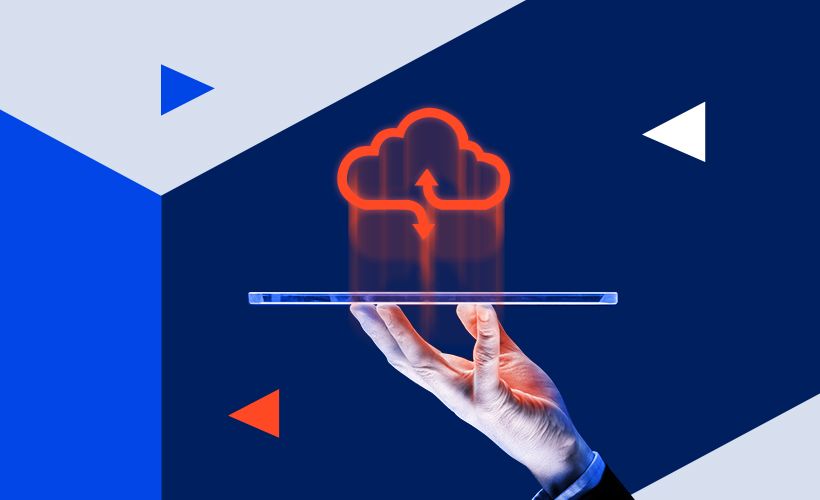
Key strategies employed for ensuring on-time delivery
Managing software projects comes with challenges and risks that can disrupt the workflow. We want to share our methods and important parts of software release, specifically about timely delivery.
We've been working on software development for more than 30 years at ELEKS. We know how crucial it is for businesses to get their projects done on time. We don't claim to have invented the wheel, but with our experience, we can confidently say we understand how to get things done on time.

Our process of making sure project is delivered on time and meet our corporate standard involves these steps:
1. Agile development methodology
We are deeply invested in our clients' priorities. We understand that changes can happen at any moment, and we must be able to respond accordingly. Agile works well because it helps teams work together and change as needed. By splitting the work into smaller parts, we can deliver working software within shorter cycles. This way, we can find and fix problems early, so there aren't considerable delays or expensive mistakes later in the project.
Moreover, agile methodologies encourage transparency and open communication among project stakeholders. By embracing a culture of continuous feedback and teamwork, teams can quickly adjust and prioritise tasks based on changing requirements and feedback. It ensures everyone shares a common vision and purpose for the project goal. As a result, software solutions are delivered on time and within budget.
2. Legal documents templates for every service
Having well-elaborated Non-Disclosure Agreements (NDA), Master Service Agreements (MSA), and Statements of Work (SOW) is essential. These make sure everyone has a clear understanding of their legal obligations.
Legal document templates help us to streamline the delivery process and save time. With our experience in dealing with documents like SOWs and NDAs, we know what areas must be included in legal documents to ensure that all potential situations are covered, and we're ready for any hiccups that might come up during the software project implementation.
We've got specific templates for each service we provide which saves us time during onboarding of new clients or extending cooperation with existing ones, making this part of service delivery as smooth as we can to reduce the time needed for negotiations. By taking such a proactive approach, we minimise potential delays.
3. Risk management and best practices database
By utilizing our established risk management approach and best practices database, our teams can identify and mitigate potential risks efficiently, allowing us to deliver quality software solutions without unexpected surprises.
We consider possible problems that could slow down our work, including factors outside our control, like customer needs and market requirements. It helps us to stay ready for any issues that may come up. We talk openly with the customer about possible problems. This way, we can deal with issues as they arise and ensure the customer knows what's going on.
Besides how we manage and deal with risks, we also make use of our best practice database. This collection has all the ways and lessons we've learned from past projects to use for new projects. It prevents us from making the same mistakes again and helps us make software faster without compromising on quality.

4. Planning and roadmapping
We guarantee to deliver the software on time through careful planning and roadmapping. But we always start by defining clear goals and requirements - because we are firmly convinced a project without them is doomed to fail.
We don't simply wait for clients to hand us the thoroughly prepared list of polished requirements; we actively identify and create them based on the customer's needs. Then we confirm these with the client so that there's a thorough understanding of all demands before moving forward.
Our release plan and roadmap provide a clear outline of key milestones, expected features, and deadlines for each development phase. We maintain focus by communicating actively with stakeholders and refining requirements. These approaches ensure that the team stays on track, and necessary adjustments are made along the way so that everyone involved remains satisfied with the progress.
Our roadmap is our guiding star, helping us navigate the complex development landscape, refine our strategies, and optimize our efforts to achieve the best possible results for our clients. However, creating a roadmap not only guides our actions, but also gives us a clear view of our final destination.
5. Project monitoring and control
Our company’s monitoring and control approach ensures that the software is delivered on time. By collecting and analyzing data, such as how fast work progresses or how quickly bugs are fixed, we can identify patterns and solve problems swiftly.
We use standardized systems across the company, like JIRA, AzureDevOps, and Trello, together with reporting dashboards to keep everything organized. These tools help teams track progress, manage tasks, and find obstacles. This approach ensures that we keep everyone in the loop, helps to stay on track with our goals and make changes when needed.
The data produced by project management tools is used to compile reports which demonstrate the project's status in its entirety - this allows stakeholders to see what has already been achieved, what steps have been taken and highlight any challenges we face.
6. Regular communication and collaboration
We promote open communication and collaboration among the development team and stakeholders to foster a culture of transparency. Our emphasis on client communication ensures a clear understanding of their needs. Conducting regular stand-up meetings, sprint reviews, and retrospectives helps identify any potential roadblocks and address issues proactively. By involving the entire team in client communication, we ensure unbiased decision-making and provide the customer with a comprehensive perspective.
7. Continuous integration and continuous deployment (CI/CD)
From the technical standpoint, we employ CI/CD pipelines to maximize the efficiency of delivery process. CI/CD is not just a methodology; it's a mindset that accelerates development, minimizes risks, and ensures engineering excellence throughout the software development lifecycle.
CI/CD approach automates the entire software delivery process, from building to deployment. With automated testing frameworks and comprehensive test suites in place, we can detect bugs and issues as soon as they arise. By running tests as part of our build pipeline, developers ensure that their software is stable and reliable.
An essential aspect of our team's workflow is implementing version control and frequent, incremental code changes in a shared repository. It allows us to identify integration problems early on, before they become major headaches down the line. This collaborative process significantly reduces the chances of late-stage defects, enhances team synergy, and keeps development on track.
Conclusions
By applying the practices outlined above, we're taking every possible precaution to anticipate and mitigate any unforeseen circumstances to guarantee timely software delivery. A combination of agile practices, solid documentation, sound risk management tactics, clear communication, and technical excellence creates a supportive environment for successful software deliveries.
In addition, we believe in continuous improvement. By reflecting on our processes and making enhancements, our teams consistently refine their practices, which leads to increased competence and proficiency over time.
These techniques embody ELEKS' value-based principles, reaffirming our commitment to delivering quality software projects to clients on time, with a guarantee of excellence.

FAQs
The process of delivering software successfully requires a well-structured and efficient approach. It includes careful planning, clear and effective communication, agile methodologies, performance monitoring using key metrics, automated testing, and continuous improvement practices. By prioritising these elements, we can successfully deliver top-quality software products that meet customer requirements and provide maximum value.
Preparing a software product for the market involves using a software delivery model. There are various ways to approach this process, which may go by different names such as software delivery lifecycle, software delivery pipeline, or software delivery process. Agile, Waterfall, and DevOps are among the most popular software delivery models.
It's a team who work together to develop, deliver and maintain software products or solutions. This team is responsible for taking a software project from its initial idea to its final implementation, ensuring that the end product meets the needs and expectations of all stakeholders involved. The team's main objective is to ensure the software is delivered on time, within budget, and to the highest quality standards.
In software engineering, delivery refers to the process of releasing software to users or clients, making it available for installation, implementation, or use by customers or stakeholders.
Related Insights




The breadth of knowledge and understanding that ELEKS has within its walls allows us to leverage that expertise to make superior deliverables for our customers. When you work with ELEKS, you are working with the top 1% of the aptitude and engineering excellence of the whole country.

Right from the start, we really liked ELEKS’ commitment and engagement. They came to us with their best people to try to understand our context, our business idea, and developed the first prototype with us. They were very professional and very customer oriented. I think, without ELEKS it probably would not have been possible to have such a successful product in such a short period of time.

ELEKS has been involved in the development of a number of our consumer-facing websites and mobile applications that allow our customers to easily track their shipments, get the information they need as well as stay in touch with us. We’ve appreciated the level of ELEKS’ expertise, responsiveness and attention to details.

